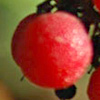Eastern Strawberry Tree is an evergreen tree (or partially deciduous in the summer) that is conspicuous for its bright red bark. The bark is smooth, tight and alludes to a trunk that is twisted underneath it as a squeezed floor mop. Every year it peels in picturesque scales, and the new bark underneath, which is at first green-brown, is then revealed. This is why lichens do not grow on this tree, since they require several years for their development, whereas the bark of the Eastern Strawberry Tree is replaced every year. The tree is short (up to 6 meters, and in rare cases up to 12 meters). The leaves are alternate, elliptical, glabrous (at the mature tree), large (5-9 cm long) dark green, and shiny on their upper side. They are carried on a short petiole. Their margin is entire or delicately dentate. The leaves of young seedlings are hairy (hirsute) and their margin is dentate. They seem to belong to another species altogether. The tree grows in anaerobic soils (with poor aeration). It apparently succeeds there due to mycorrhiza (feeding with the help of symbiotic root fungi). This may be the reason why it is difficult to cultivate this plant in ornamental gardens, even though gardeners rightfully like the tree. It is difficult, by successes in growing domesticated trees have been reported.
Arbutus andrachne blooms in spring, in March and April. The flowers are arranged in sparse racemes, with numerous flowers. The flower is small (with a diameter of 8 mm). The calyx is short, green, and divided into lobes. The corolla is white to beige, and has the shape of a swollen jar (urceolate) which hangs with the opening facing downwards. Its lobes are fused almost along their entire length. The flower is beautiful when observed from up close. The bloom is plentiful, and at the right time of year the hiker who keeps eyes on the ground recognizes that he is walking near an Arbutus andrachne by the carpet of flowers that dropped. The flower secretes a dilute nectar, and flies and bees come en masse to enjoy it and pollinate the flowers. The fruit ripens in the autumn. It has the shape of a red sphere with a diameter of 1 cm. Its surface is uniformly tuberculate. When ripe it is tasty, even though it is full of hard seeds. The sign of a ripe fruit is that its red color turns almost black, and it becomes soft. A non-ripe fruit is astringent, and dries the mouth.
Arbutus andrachne grows in the Mediterranean Maqui in northern Israel, and a also in the center of the country. It usually grows dispersed, as single individuals, and achieves dominance only on marl and soft chalk soils. Its global distribution is in the countries of the East Mediterranean.
The origin for the Hebrew name (ktalav) is in Arabic, a combination of the words katal av (whose meaning in Arabic is similar to the meaning in Hebrew – killed & father). Legends have arisen around the name, inspired by the blood-red bark, about a son who murdered his father. The convoluted branches, like arms with branched muscles, have been connected to legends about competition and effort. The Greek poet Horace wrote that idlers like to sit in the shade of Arbutus andrachne. The wood is hard and resistant to rot, and was therefore used for making ploughs, tool handles, wooden bowls, and the trunks were used for roofing. In folk medicine all parts of the tree were used against stomach aches, constipation and skin lesions.
The genus contains 18 species, with 1 species in Israel. Arbutus andrachne is the only representative of the Ericaceae family in Israel. Many of the members of this family grow in acidic soils, in marshes and in primeval areas such as young lava estuaries or in the far north. Some of the plants have edible fruits (berries), such as blackberries and cranberries, and some are ornamental plants, such as azalea.
Ericaceae grow in non-aerated (anaerobic) acidic soils, by symbiosis with fungi that grow within the root tissue and send their hyphae into the soil around them. This type of symbiosis is called mycorrhiza, which is a combination of the words fungus and root. Mycorrhiza is common in nature, but is especially important in plants of this family. In soils in which these plants grow there is little degradation of organic material and the nutrients required by the plants, i.e. nitrogen, phosphorous, zinc, etc. are bound within insoluble organic compounds which the plants are unable to utilize. The fungus secretes enzymes into the soil which degrade these compounds and release the nitrogen and other nutrients near the roots. The fungal hyphae absorb these nutrients and transfer them to the roots of the plant. The fungus thus enables the normal nutrition of the plant. The literature also mentions the possibility that the fungi degrade toxic materials that are found in these soils which inhibit the growth of roots.
Chalky soils in Israel suffer from poor aeration, and are rather anaerobic, such that Arbutus andrachne has an advantage there. Plants from the Orchidaceae, Lamiaceae and Cistaceae families, which also have a well-developed mycorrhiza, also grow in these soils.
Written by Mike Livne





